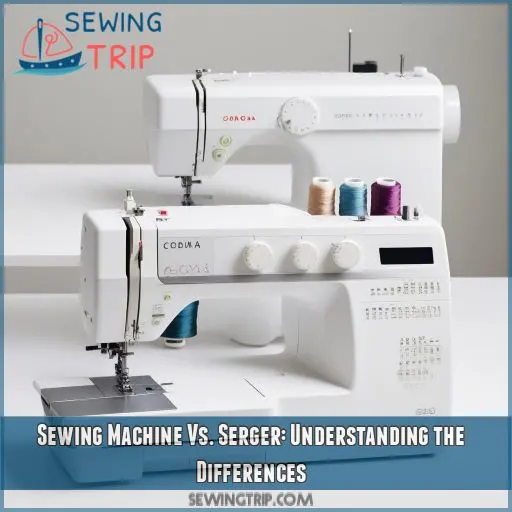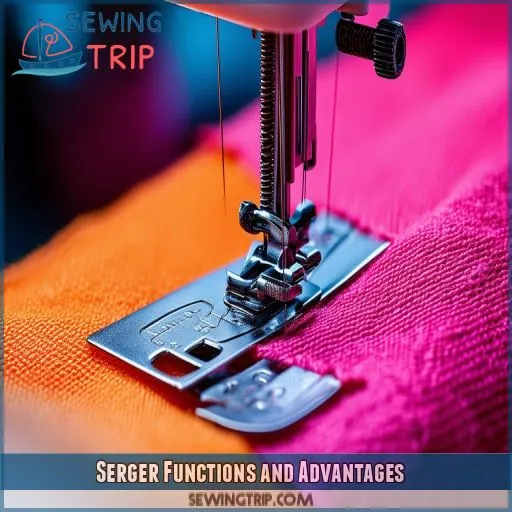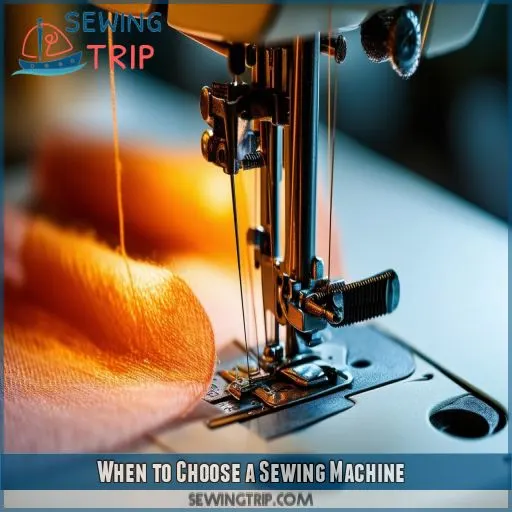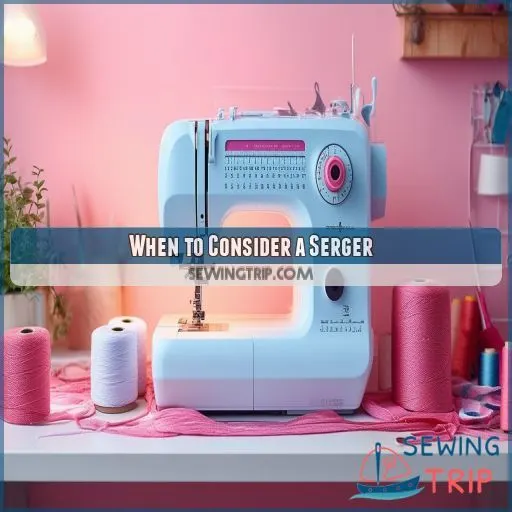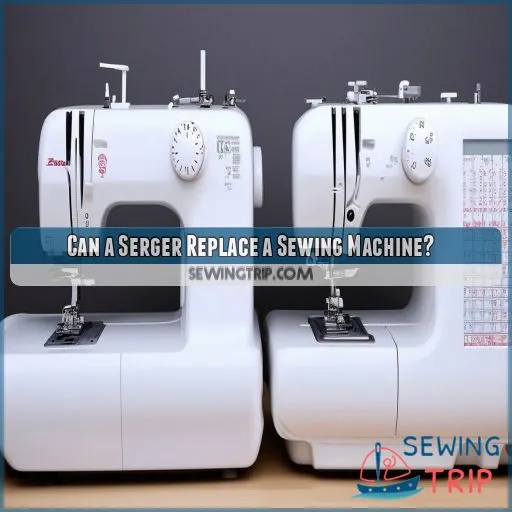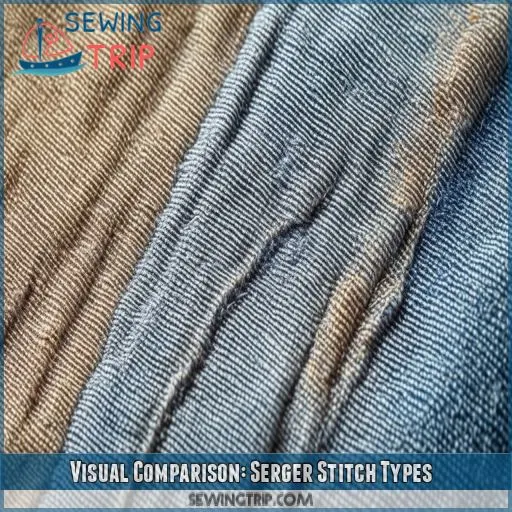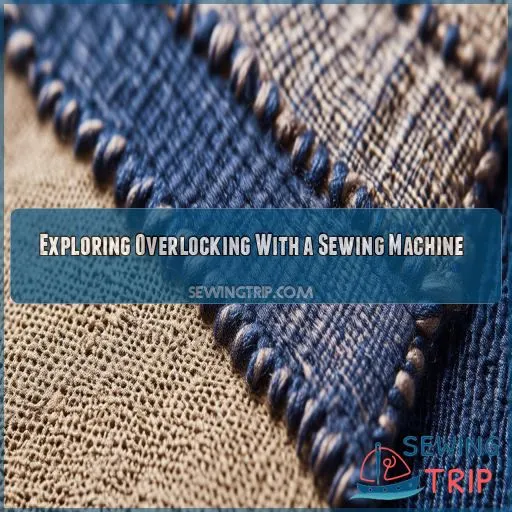This site is supported by our readers. We may earn a commission, at no cost to you, if you purchase through links.
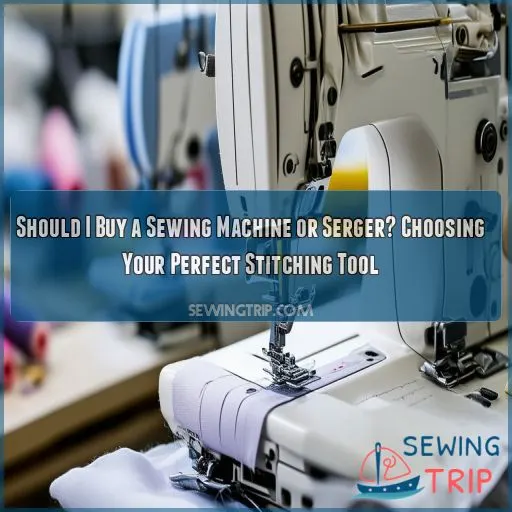
When considering a genuine sewing machine vs. serger, it really boils down to the demands of your projects. A sewing machine is primarily utilized for basic stitching, constructing buttonholes, and creating decorative work. Professional seams are much better done with a serger, and the latter does not have as much difficulty working with stretchy materials as the former does.
Both machines manage to do very unique things, and therefore, knowing their differences only adds to the significance of understanding them. We will discuss their strengths so that you may be able to choose the right tool to use in making your sewing projects perfect and achieving flawless results always.
Table Of Contents
- Key Takeaways
- Should I Buy a Sewing Machine or a Serger?
- Sewing Machine Vs. Serger: Understanding the Differences
- Sewing Machine Capabilities
- Serger Functions and Advantages
- When to Choose a Sewing Machine
- When to Consider a Serger
- Can a Serger Replace a Sewing Machine?
- Visual Comparison: Serger Stitch Types
- Exploring Overlocking With a Sewing Machine
- Frequently Asked Questions (FAQs)
- Conclusion
Key Takeaways
- Sewing machines are the Swiss Army knives of the fabric world – they’ll handle your basic stitching, buttonholes, and even throw in some fancy decorative work for good measure. Perfect for beginners or if you’re not ready to dive into the deep end of the sewing pool just yet.
- Sergers are the speedsters of seam finishing – they’ll zip through your projects faster than you can say "professional-looking edges." If you’re working with stretchy fabrics or want to give your knits a polished look, a serger’s your new best friend.
- Don’t put all your eggs in one basket – 80% of home sewers have both machines for a reason. It’s like having both a hammer and a screwdriver in your toolbox; sometimes you need one, sometimes the other, and sometimes both to get the job done right.
- If you’re on a tight budget or just dipping your toes in the sewing waters, start with a sewing machine. You can always add an overlock foot attachment to get a taste of serger life without breaking the bank. It’s like getting training wheels before you’re ready for the Tour de France of sewing!
Should I Buy a Sewing Machine or a Serger?
Deciding whether to buy a sewing machine or a serger depends on your sewing goals and fabric preferences.
Sewing machines are versatile, handling basic stitching, buttonholes, and decorative work on non-stretchy fabrics. They’re ideal for beginners and varied projects.
Sergers excel at professional seams, working with stretchy fabrics, and creating polished finishes. They’re faster but more specialized.
If you’re just starting out or working mainly with woven fabrics, a sewing machine is your best bet. For knits or if you’re after that professional edge, consider a serger.
Can’t decide? Many sewists find that having both tools in their arsenal is the perfect recipe for stitching success.
Sewing Machine Vs. Serger: Understanding the Differences
When choosing between a serger and a sewing machine, you’re weighing specialized power against versatility. Sergers excel at creating professional edges with overlock stitches, but they’ve got limitations. You can’t do buttonholes or zippers with them.
Sewing machines are more versatile, handling a wider range of tasks. For beginners, a sewing machine is often the better choice.
If you’re on a budget, consider that some sewing machines have overlock attachments. They’re not as efficient as sergers, but they’ll get the job done.
Sewing Machine Capabilities
Your sewing machine offers versatile capabilities for basic and advanced projects. It can handle essential tasks like basic stitching, creating buttonholes, attaching zippers, and producing decorative stitches to enhance your creations.
Basic Stitching
You’ll find that basic stitching on a sewing machine is your bread and butter. From straight stitches to zig-zags, you’re in control.
Adjust fabric tension, select the right needle, and choose thread weight to match your project. Stitch length matters too.
Regular maintenance keeps your stitching smooth.
Buttonholes and Zippers
While sergers are okay for seam finishing, they can’t do buttonholes or zippers. Your sewing machine has your back on this one.
It’s going to make perfect buttonholes and reinforce them to be strong. Where it comes to putting in a zipper, your trusty machine really helps you out by installing it with ease.
These features are very critical in garment construction since they give control over closures and the fit.
Don’t get rid of that sewing machine just yet!
Decorative Stitching
A sewing machine can do just about anything in terms of decoration. From beautiful embroidery stitches to dramatic appliqué, you’re in control of the flair that you put into your project.
You’ll also make lovely quilting stitches and decorative hems, and you’ll even be able to mock certain flatlock stitches.
Yes, sergers have rolled hemming capabilities that sewing machines can’t do, but they can’t do what a sewing machine does for embellishments.
Only your imagination is the limit when it comes to what you can do with decorative embroidery and other unique finishing touches.
Serger Functions and Advantages
While sewing machines handle basic stitching, sergers excel at creating neat, professional seam finishes. You’ll find that sergers use multiple threads simultaneously, typically 3-4, to create strong seams while trimming excess fabric edges in one pass.
Neat Seam Finishing
As far as neat seam finishing goes, sergers are truly the sewing world’s MVPs. They’ll give your projects such perfection and professionalism that hardly anything can compete with what they provide.
A serger can hit very high speeds, up to 1700 stitches a minute, to quickly create very strong seams on any type of fabric.
The cutting knife trims the excess material with clean, finished edges that avoid fraying while stitching.
Multiple Thread Usage
With a serger, you’ll harness the power of multiple threads for superior seam strength. Unlike a sewing machine’s single thread, sergers typically use 3-8 threads simultaneously. This allows for better thread tension control and versatility when working with stretchy fabrics. You can mix thread colors, types, and thicknesses for creative effects, enhancing your project’s professional finish.
Edge Trimming
Beyond multiple thread usage, your serger’s edge trimming capability is a game-changer. It trims excess fabric while stitching, creating neat seams and protecting your fabric from fraying. This feature boosts durability and gives your projects a polished look.
With an average sewing speed of 1,500 stitches per minute, you’ll finish edges faster than ever.
The differential feed system handles chiffon-type fabrics with ease.
When to Choose a Sewing Machine
If you’re new to sewing or primarily work with non-stretchy fabrics, a sewing machine is your best starting point. You’ll find a standard sewing machine sufficient for most beginner projects and tasks that don’t require professional-grade seam finishes.
Beginner Projects
When you’re just starting out, a sewing machine is your go-to tool. It’s perfect for beginner projects, offering basic sewing functions like straight stitching and buttonholes. You’ll master hand sewing techniques and learn to control stitches per minute. Unlike a serger, which can be overwhelming, a sewing machine eases you into the craft, building your confidence stitch by stitch.
Non-Stretchy Fabrics
For non-stretchy fabrics, your trusty sewing machine is often the go-to choice. It’s perfect for:
- Crisp cotton shirts
- Sturdy denim jeans
- Elegant silk dresses
- Cozy wool coats
- Delicate lace overlays
While sergers excel with knits, sewing machines handle woven fabrics with ease. Their versatility shines through various edging types and embroidery stitches. For beginners, a sewing machine’s overlock attachment can mimic some serger functions, though with less power and seam durability.
No Professional Seams Needed
If you’re only going to deal with non-stretchy fabrics and have no need for durable seams or professional finishes, a sewing machine will be what you want.
It’s great for simple projects where non-decorative stitching will suffice.
Where you don’t want knit fabrics or complex designs, a sewing machine is going to bring flexibility without the hassle of a serger.
Should you buy a sewing machine or a serger? For beginners, start simple.
When to Consider a Serger
If you’re working with stretchy fabrics or hemming knits, a serger can be a game-changer for your sewing projects. You’ll find that a serger excels at creating professional-looking seams, offering speed and precision that can elevate the quality of your garments and other textile creations.
Working With Stretchy Fabric
When dealing with stretchy fabric, using a serger is the magic formula. These machines are designed to easily take on the elasticity of the material and dispel wavy seams. You’ll need to:
- Serger tension adjustment for perfect stitch-forming
- Try Overlock Stitch Variations
- Choose the proper threads to work with your fabric type.
- Select the appropriate weight of needle for your fabric
Master these techniques and you’ll be handling stretchy fabrics with professional results.
Hemming Knits
When hemming knits, a serger’s your secret weapon. You’ll breeze through stretchy fabrics with ease, thanks to its specialized needle selection and adjustable thread tension.
Different fabric types are no match for a serger’s versatility. You’ll achieve consistent seam allowances and even throw in some decorative stitches for flair.
With a serger, you’ll conquer those tricky knit hems like a pro.
Creating Professional Seams
When you really need that professional-looking seam, it’s a serger that you’re going to prefer. In comparison with a sewing machine with a serger foot option, the accuracy, in this case, is quite impeccable.
You’ll feel the difference in its usage on stretchy fabric and its durability in hems using knits. Because with a multiple-thread serging system, raw edges are enclosed by stitching, and that means no fraying.
It also means your projects will look as store-bought as the expensive brands in the mall. It’s your secret weapon for that polished, ready-to-wear finish.
Can a Serger Replace a Sewing Machine?
While a serger excels at creating professional seams and handling stretch fabrics, it can’t fully replace a sewing machine. You’ll still need a regular machine for beginner projects, buttonholes, and zippers.
Sergers are specialized tools that complement sewing machines, not substitutes. If you’re on a budget, consider an overlock attachment for your sewing machine. It’ll give you similar functionality, though not quite as robust as a dedicated serger.
For most sewists, the ideal setup is having both machines. This combo allows you to tackle any project with confidence, from basic repairs to intricate garments.
Visual Comparison: Serger Stitch Types
You’ll find that sergers offer a variety of specialized stitch types, each serving a unique purpose in garment construction. Let’s examine four key serger stitches: the cover stitch for hems, the flatlock stitch for open seams, the overlock stitch for encasing seams, and the rolled hem for covering fabric edges.
Cover Stitch
While a serger can’t fully replace a sewing machine, it offers unique stitches like the cover stitch. This versatile stitch is ideal for hemming knits and creating decorative finishes. You’ll need a specialized cover stitch machine or a serger with cover stitch capability to achieve this professional look.
Flatlock Stitch
Moving from cover stitches, let’s explore the flatlock stitch. It’s a game-changer for garments like swimwear. You’ll create durable seams that lie flat, preventing chafing. This stitch offers an easy finish and decorative options. With a serger, you’ll master flatlock stitches in no time.
Overlock Stitch
While the flatlock stitch creates open seams, the overlock stitch encases them. You’ll need to adjust overlock tension, seam width, and differential feed for perfect results. Experiment with overlock thread types and colors to achieve professional finishes. This versatile stitch is ideal for preventing fraying on various fabrics.
Rolled Hem
You’ll love the rolled hem finish a serger creates. This narrow, tightly-wrapped edge is perfect for delicate fabrics. Your serger’s rolled hem machine function trims and encases the fabric’s edge in one swift motion. Adjust the rolled hem width for various effects on different materials.
Exploring Overlocking With a Sewing Machine
If you’re considering overlocking with your sewing machine, then you may want to explore the use of an overlock foot attachment. Attached, it will let you do a little overlocking, but it’s really limited in speed, kinds of stitches, and edge trimming compared with a standalone serger.
Overlock Foot Attachment
If you’re not ready to dive into the investment in a serger, don’t worry! You can dabble in overlocking by simply using your regular sewing machine and an overlock foot attachment.
This little piece of ingenuity works on many sewing machines and is often available as an aftermarket accessory. It’ll give you a taste of serger functionality without the full commitment.
While it doesn’t have the speed or range of stitches that a dedicated serger has, the overlock foot does allow one to finish off edges and make simple overlocks.
It’s one good way to dip your toes in the water of overlocking—to see if you’re ready to take the plunge into sergerland.
Limitations Compared to a Serger
While an overlock foot attachment can mimic some serger functions, it has limitations. You’ll find that it can’t match a serger’s speed or precision. The attachment won’t trim fabric edges as you sew, and it can’t create the rolled hem you’d get with a serger.
Your sewing machine’s overlock stitch might not be as durable or stretchy as a true serger stitch, especially for knits. Remember, a serger uses multiple threads simultaneously, creating stronger seams.
If you’re serious about professional-looking finishes or working with stretchy fabrics often, a serger’s capabilities outshine the overlock foot attachment.
Frequently Asked Questions (FAQs)
Do I want a serger or sewing machine?
You’ll want a sewing machine if you’re a beginner or need versatility for various projects. Opt for a serger if you’ve got sewing experience and crave professional finishes, especially when working with knits or creating rolled hems.
Can sergers replace a sewing machine?
Ready to streamline your sewing? While sergers excel at finishing edges and seams, they can’t fully replace sewing machines. You’ll still need a regular machine for buttonholes, zippers, and topstitching. Sergers complement, not substitute, your trusty sewing companion.
What can a serger do that a sewing machine can’t?
You’ll zip through knits and create professional finishes with a serger. It trims seams, encases edges, and uses multiple threads for ultra-durable stitches. You’ll tackle sheer fabrics with ease and craft perfect rolled hems in seconds.
Should I buy an overlocker or a sewing machine?
You’re in a stitch! For beginners, start with a sewing machine. It’s versatile for most projects. If you’re diving into knits or need professional finishes, add a serger later. Consider your sewing goals and budget when deciding.
How noisy are sergers compared to sewing machines?
Sergers are typically noisier than sewing machines due to their higher operating speeds and multiple thread cones. You’ll notice a louder, more intense hum. However, newer models have improved noise reduction features, making them more comparable to sewing machines.
Can sergers use regular sewing machine thread?
You’re in luck! While sergers typically use specialized thread, you can often use regular sewing machine thread in the needles. However, for best results and durability, it’s recommended to use serger-specific thread in the loopers.
Are sergers more difficult to maintain than sewing machines?
Sergers aren’t necessarily harder to maintain, but they’ve got more moving parts. You’ll need to clean and oil them regularly, just like sewing machines. The key difference? You’ll be threading multiple needles and loopers instead of just one.
How much space do sergers typically require?
You’ll need about 2-3 square feet for a serger. They’re compact but require space for thread cones and fabric handling. Consider a dedicated sewing area or a fold-away table to maximize your workspace efficiency.
Can sergers handle heavy-duty fabrics like denim or leather?
Yes, sergers can handle heavy fabrics like denim and leather. You’ll need the right needles and adjust tension settings. For extremely thick materials, a heavy-duty serger might be necessary. Always test on scraps before tackling your project.
Conclusion
Statistics show that 80% of home sewers own both a sewing machine and a serger.
When deciding whether you should buy a sewing machine or a serger, consider your project needs. Sewing machines excel at basic stitching and decorative work, while sergers create professional seams and handle stretchy fabrics with ease.
Each tool has its strengths, and many sewers find value in owning both. Evaluate your sewing goals, fabric preferences, and desired finish quality to make the best choice for your crafting journey.

